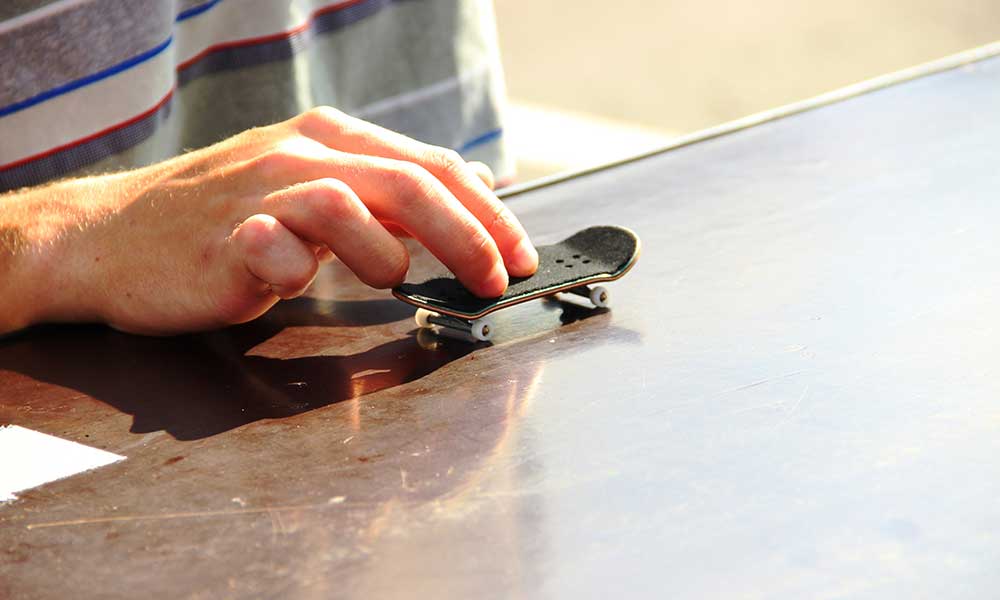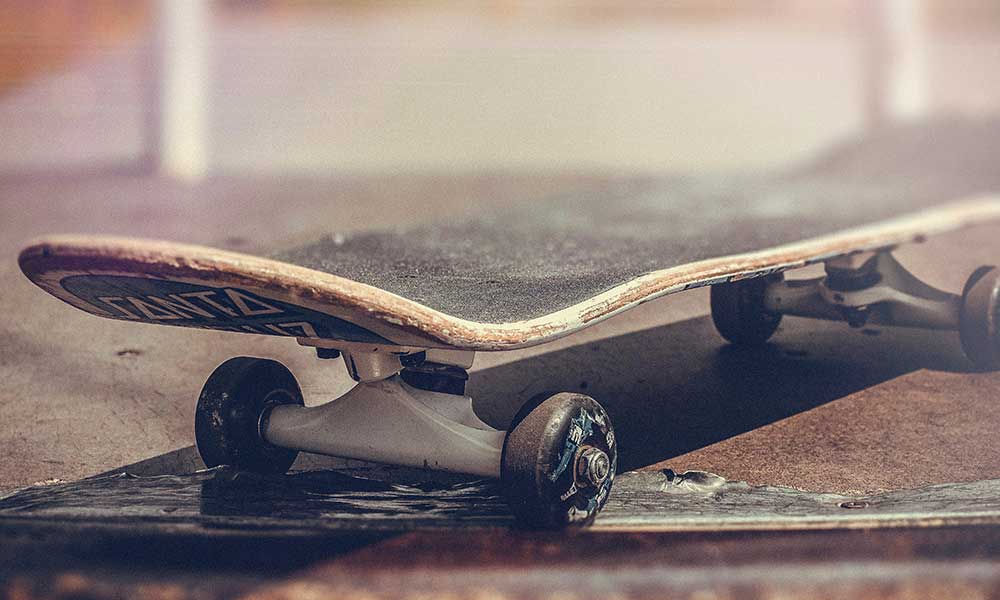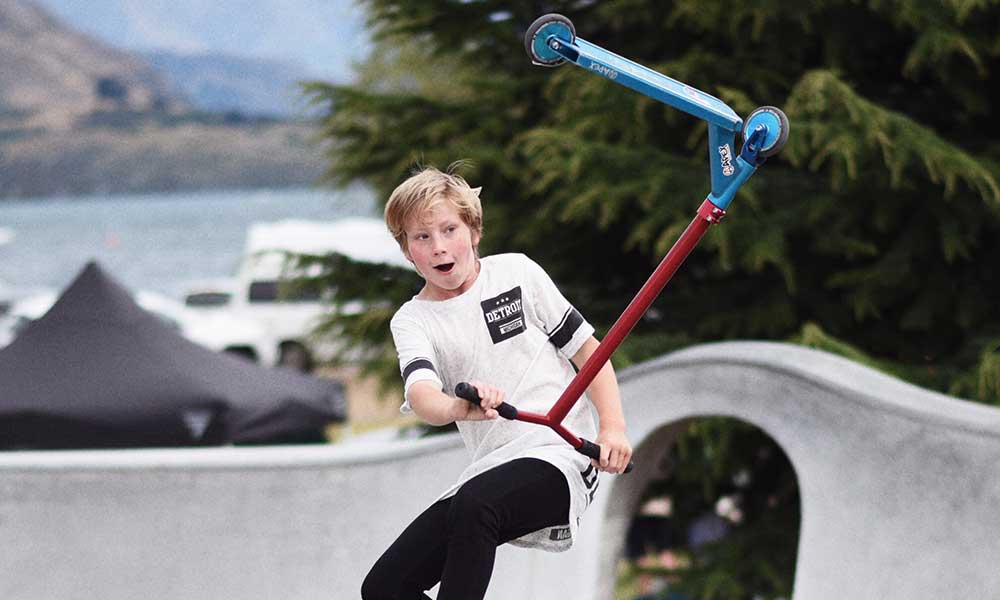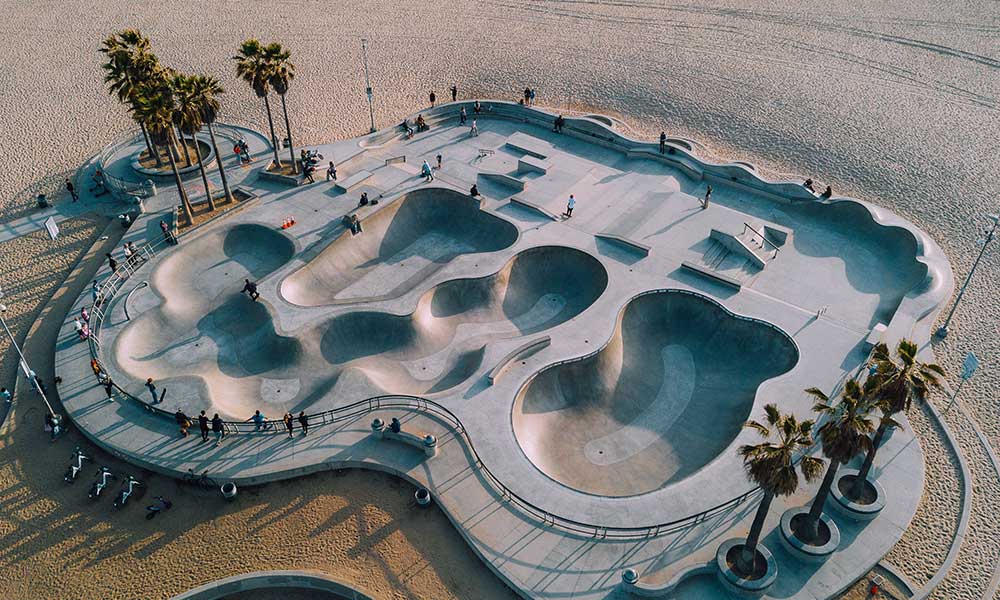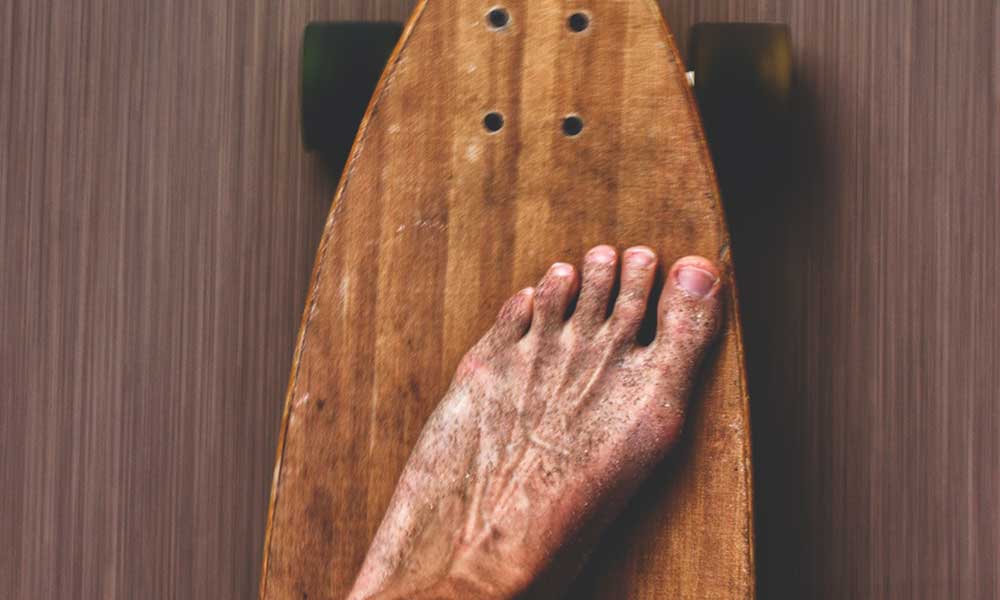If you’re new to fingerboarding and are keen to learn about this fun and accessible sport, this is the guide for you! We’ll answer questions such as “What is fingerboarding” and “What are the components of a fingerboard?” while highlighting the sport’s best riders, tricks, boards, and brands.
It’s your complete guide to fingerboards and fingerboarding.
What is Fingerboarding?
Fingerboarding is the act of “riding” a fingerboard, which is essentially a miniature skateboard made to about 1:8 scale.
The fingerboarder uses their index finger and middle finger to replicate the lead foot and back foot on a skateboard, and by jumping, flicking, and spinning with those fingers, they can perform equally epic fingerboard tricks.
A fingerboard, like a skateboard, is often made of wood and fitted with a layer of grip tape. It also contains miniature trucks and wheels and moves with the same fluidity as a full-sized board.
Typically, the first three things that people learn about fingerboarding are:
- Fingerboards are not just toys
- Fingerboarding is not as easy as it looks
- Fingerboarding is fun
Fingerboards were first developed in the 1960s, but they were little more than a novelty at the time. They were basically just cheap mini skateboards that looked cool on a keychain. But that changed in the late 1980s and early 1990s when fingerboards were first mass-produced.
Why Do People Fingerboard?
Fingerboarders come from a variety of different backgrounds and get into fingerboarding for many different reasons. For some, it’s just a great way to pass the time and one that doesn’t come with an injury risk like skateboarding.
For the majority, it’s something that they do when they can’t skate or something that they use to visualize skate tricks and plan competition lines.
Who Invented Fingerboarding?
Lance Mountain is often credited with popularizing fingerboards. The professional skateboarder featured in the 1985 Powell-Peralta Future Primitive video, where he used a homemade fingerboard to practice tricks in a double sink.
In 1987, Somerville International’s Fingerboard began mass-producing these boards and by the late-90s and early 2000s, they were commonplace in the skating community throughout the United States.
In fact, fingerboards were even included in McDonald’s Happy Meals in the early 2000s.
The period also saw the birth of Tech Deck (on Amazon), a brand that has become synonymous with high-quality fingerboards.
Parts of a Fingerboard
A fingerboard consists of the following components:
- Fingerboard Deck: The main part of the board and where the rider’s fingers are placed. Fingerboard decks are made out of wood or plastic and can be treated and shaped in a variety of different ways.
- Trucks: The small metal bars onto which the wheels are attached.
- Wheels: Often made from plastic or resin, wheels may include bearings and come with a variety of finishes.
- Grip Tape: A layer of tape added to the top of the deck for extra grip.
- Nuts and Screws: Attaches the pieces together and ensures that everything remains solid.
- Bushings: Cylinders added to the center of the trucks to provide a smoother ride.
In years gone by, fingerboards were mass-produced using cheap ingredients, including plastic. These days, there are a number of specialist manufacturers that devote just as much care and quality materials to fingerboards as the best brands devote to skateboards.
As with anything else, you get what you pay for and if you’re willing to spend a little more, you’re more likely to get a higher quality board.
Fingerboard Accessories
You can fingerboard anywhere and with pretty much anything. Take your board with you to the park and look for walls, tables, boulders, and other natural obstacles.
Alternatively, you can make them yourself using whatever scraps of metal, wood, and cardboard you can find at home.
If you have the funds to spend on your very own high-tech fingerboarding equipment, you can find all of the following items at your local skate shop or fingerboarding shop:
Fingerboard Ramps
Ramps are an essential part of any fingerboard set up and are available in a variety of styles. There are half and full ramps available and they come in many different materials and sizes.
The best ramps usually begin at around $30 but this can go above $130 for bigger and more complicated ramps. If that’s a little too rich for your blood, there are cheaper options on Amazon. These budget versions are typically made from plastic while the expensive ones tend to be made from wood and metal.
Fingerboard Parks
Fingerboard parks tend to be complete units that include a little bit of everything, such as ramps, walls, and rails. As with all other fingerboard accessories, the price of park sets can vary considerably.
If you want the very best, you could be looking at several hundred dollars. If you’re a complete newbie who just wants to have a little fun, you can find compact silicon units on Amazon for less than $40.
Pivot Cups
Pivot cups are small pieces of tubing that are placed in the baseplate to deliver a smoother and more comfortable ride. Pivot cups are used on skateboards to compensate for the weight of the skater and ensure that the trucks can still pivot.
On fingerboards, they are not necessary as there isn’t a great deal of weight on the board. However, some fingerboarders choose to add them for improved performance, durability, or purely for aesthetic reasons.
Rails and Walls
A rail is a standalone metal object that resembles a mini handrail and is used for grinding. Walls are available as well and serve the same purposes. These objects can be added to mini skateparks and used to perform grind and stall tricks.
Stickers
Fingerboarders, just like skateboarders, like to decorate their boards using stickers. These are usually very inexpensive (typically less than $0.50 for basic circular stickers) and they come in many styles, colors, and shapes.
Display Cases
If you’re passionate about fingerboards and have a growing collection, you may want to invest in a fingerboard rack or display case. These little storage units will ensure that your boards are not being tossed in drawers when you have finished with them and will let you show them off.
Fingerboarding FAQs
If you still have a few questions about fingerboarding, the following fingerboard FAQs will help.
What Was the First Fingerboard Brand?
The first fingerboards were toys. They looked the part but they weren’t meant to be ridden.
The first boards that could be ridden were produced by Somerville International’s Fingerboard in the late 1980s.
Is Fingerboarding Easy?
Unfortunately, it’s one of those sports that looks a lot easier than it actually is. If you’re buying a fingerboard because you think it’ll be an easy way to perform tricks and show off to friends, you’re going to be very disappointed.
Some have even argued that it is harder than riding a skateboard, but this is unlikely. That would certainly be the case if you have experience with board sports and have never used a fingerboard before, but for the average person approaching both sports as a newbie, fingerboarding should be easier.
As with all sports and activities, practice is key. If you don’t nail that ollie first-time, then keep trying and you will get there eventually.
Is Fingerboarding a Real Sport?
There are fingerboard championships and it also falls under the definition of a “sport”, which is an athletic activity that requires skill or physical prowess. Of course, the “athletic” aspect here is debatable, but the same could be said for darts, snooker, pro gaming, and pool, all of which are often classified as sports.
It’s certainly not a massive sport that you’ll see on television or at the Olympic Games, but it does require a lot of skill and there are trophies and accolades to win.
Are There Other Fingerboard Sports?
Fingerboarding was one of the first “finger sports”, but others have been created since.
- FingerAirboarding: A FingerAirboard is similar to a fingerboard but with a wider deck. Air is also used to keep the board in the air, where the rider can freely perform tricks.
- Handboarding: The hands are used instead of the fingers, requiring much more space and reducing this to a niche and relatively unknown activity.
- Fingersnowskating: Also known as fingersnowboarding, it’s basically fingerboarding on snow and without the use of wheels or trucks.
- Finger BMX-ing: Mini BMX bikes are used to perform tricks on mini ramps and other obstacles.
Summary: What is Fingerboarding?
At first glance, fingerboarding can seem a little bizarre. After all, it’s essentially just skateboarding for the fingers, and to the uninitiated, it seems like nothing more than a passing fad or something to keep your idle hands busy.
But as the above guide proves, there is so much more to this sport. It’s fun, it’s cheap, and the learning curve is nowhere near as steep—or as painful—as skateboarding.
If you’re looking for a new hobby, invest in a fingerboard and see what all the fuss is about!

